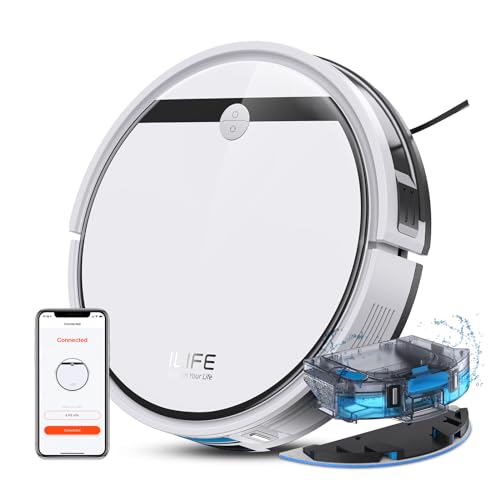How to Find the Best Robot Vacuum
If you’re willing to live without smart capabilities like mapping, and don’t mind cleaning the trash bin every 60 days or then, a basic robot vacuum is likely to work for you. Select a model with an uncluttered base that can work with voice assistants.
 It excels at removing dirt, cat litter and pet hair on tile floors, hardwood floors and carpeting that is lower-pile better than any other vacuum we’ve tried. It also maps and set virtual no-go zones in rooms or areas.
It excels at removing dirt, cat litter and pet hair on tile floors, hardwood floors and carpeting that is lower-pile better than any other vacuum we’ve tried. It also maps and set virtual no-go zones in rooms or areas.
1. Powerful Suction
A robot vacuum will help you keep up with the dust, pet fur and dander that collects on your floors every day. It can also cut down on how often you need to do a deeper clean which will save your time and effort. The best models come with powerful suction that can tackle most messes with ease and leave your home cleaner.
You can cover a larger area by using a robot vacuum and mop, which is especially beneficial if you live in an extensive home. There are models that has a water tank integrated into the chassis or as an extra piece that you can remove after vacuuming. It will need to be filled and empty and refilled, which is an additional task to complete.
In a perfect world, you’d clear your floors before you used your robot vacuum to prevent it from crashing into objects. In most homes, however it’s not feasible or desirable. Most robots allow you to utilize an app for your smartphone to build virtual barriers the robot can detect. Certain models have no-go zones, which you can flag areas you don’t wish it to enter. For example an area for children’s play or a pile cords in a corner.
If you’re looking to buy a basic robot vacuum without all the bells and whistles, this model made by networking company TP-Link is a good choice. It’s quiet, it works on both hard floors and carpets with low pile and can be programmed using the app to mop and vacuum at your convenience. It’s got a long battery life that can last up to 180 minutes.
2. Simple to operate
In general robot vacuums require little input from you. They make use of navigation tools such as sensors lasers, cameras and sensors to move around obstacles and remove dust, food crumbs and pet hair from hard floors, tile, hardwood and low-pile carpets. Many have boundary strips that help them stay within the walls of a room, while higher-end models can be set to automatically wake up and start cleaning at a set time. Some models have fall detection technology to help them avoid falling down stairs or getting caught in cords.
If you’d like to control your robot vacuum from the comfort of your couch, look for models that integrate voice assistants such as Alexa and Google Assistant. Also, look for models that connect to Wi-Fi and allow you to begin cleaning sessions from anywhere using an app. You might want to choose a model that has an extremely long-lasting battery as well as a large dust bin, depending on the size of your house.
Certain robot vacuums are also mopping. They make use of water reservoirs to wash the floor. This is helpful for everyday mopping, but will not work for extra-tough messes, like pet poop, or other wet spills. You can pick hybrids that have an able mopping pad made of microfiber, or a self-emptying version that allows you to stay for up to 60 days before emptying the base.
3. Smart Mapping
Some robots use advanced mapping technology to build a detailed map as they clean. This allows them to avoid crashing into furniture or tripping over cords or chairs. This feature is usually only available on more expensive models, but it’s certainly one of the most effective ways to ensure your robot has a complete understanding of the layout of your home and knows where to go next when it’s low on battery.
If you don’t want your robot navigating into areas of your home that you’d rather it stay away from (like your children’s toys or the mess of device cords in the corner) Most robots provide the possibility of creating virtual barriers, either with their apps or a set of physical boundary strips. This allows you to block off zones that you don’t want your robot to venture into, so it can focus its attention on the areas that require the most attention.
Many robots will also automatically change floors depending on the type of flooring they are cleaning. This can be done by changing from carpet to hard flooring or by focussing on certain areas of your home, such as corners and baseboards. This feature was effective in our tests and enhanced the vacuum’s performance on both hardwood flooring and low-pile floor carpeting. It’s nevertheless important to put away furniture and cords before using your robot vacuum to ensure that it doesn’t get stuck or run into something it shouldn’t.
4. Remote Control
The majority of robot vacuums have WiFi capabilities and can be controlled with voice commands, Google Assistant, Amazon Alexa or Siri Shortcuts. Many robot vacuums connect to smart home systems, and create an outline of the area they clean after each session. This lets them “learn” how your home is laid out and to plan more efficient routes during future cleaning sessions. Certain models have obstacles avoidance built-in that prevents them from damaging furniture and getting stuck on things such as loose charging cables or pet hair.
Most robots have a remote control that can be used to guide them around your house. Most robots are controlled by a mobile app, which offers more features. It is possible to create multiple cleaning schedules, create an inventory of your favorite rooms and even manually guide your robot to certain areas using directions on the screen.
Certain models have no-go zones that are virtual barriers that you can create in the app to stop the robot from entering certain areas (like toys for children or dog beds and bowls). Certain apps let you draw a map of your house and provide detailed information about the floors. The Roborock S7+ app has many useful features that will aid in cleaning the house. However its interface isn’t as sleek as iRobot or Shark.
5. Long Battery Life
Robot vacuums that can sweep your entire house without stopping for a recharge or to empty their bins save time and effort. Certain robot vacuums can work with smart home platforms like Alexa, Google Assistant, and Siri Shortcuts to enable hands-free operation. They can also create an outline of the space for you to program them for certain areas or rooms and to stay clear of obstacles.
The majority of robot vacuums can detect objects, however the iRobot j7 offers advanced features like “home mapping” and obstacle avoidance. These can make your life much easier (although one of our test bots did “eat” a couple of socks). If you’re looking to take your home maintenance to the next level opt for a robotic mop with a tank of water that you fill and empty yourself.
While none of the models we tested could beat the dirt-picking power of a stand-up model, they all do a great job of cleaning carpets with low pile and hard floors. They are excellent at sweeping up fine dirt, food crumbs and dirt that has been tracked into. They also can handle screws and nuts made of metal and stray cat litter. The most effective robot vacuums are able to easily work their way around furniture and are great at cleaning edges and corners as well. For a basic model that functions on its own and is reasonably priced look into the Eufy 11S.
6. Convenient Self-Charging
With the right setup and the right setup, a robotic vacuum can help you keep your home looking and feeling cleaner regularly, without a lot of effort. You can schedule cleanings through the app, and you can set up no-go areas to ensure that your robot does not get in the way of your plants or favorite chair. A majority of our top picks will empty their dustbins for you and clean their docking stations.
The top robot vacuums can be programmed to clean your floors on a regular basis for weeks or even months at a time, removing you from the tedious chore of manually mopping and sweeping your floors on a daily or weekly basis. This lets you spend more time doing things you enjoy and reduces the amount of time your floors have to be cleaned manually.
In the course of testing, the Q Revo was able to capture fine particles like oatmeal and baking soda, heavier debris such as metal screws and nails, and fluffy stuff like pet hair. It isn’t equipped with the smart robot vacuum – Web 018 Dmonster said – mapping and object-avoiding features found in our top picks, but it is still a good choice for most families.
The j7’s best robot vacuum cleaner for pet hair feature is its ability to spot and avoid obstacles such as power cords and socks, shoes, and pet waste. This means that you don’t need to clean up after using your 360 robot vacuum. However, messy rooms could cause your robot to get stuck and do an inadequate job.
